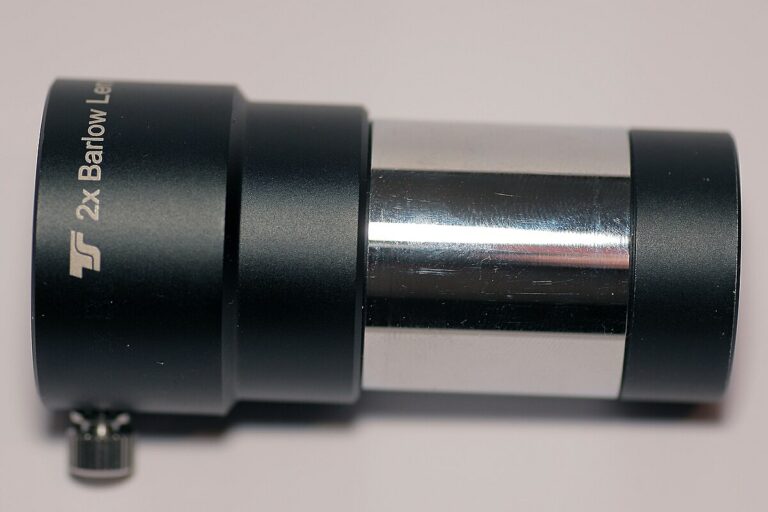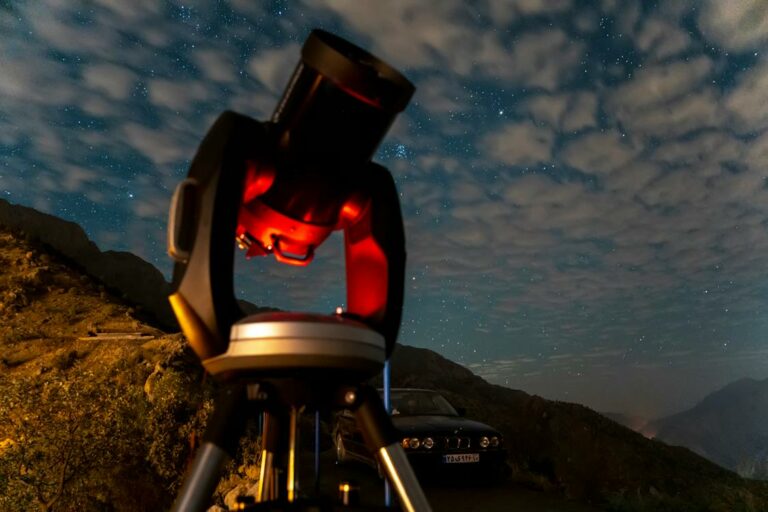Computerized telescopes are a popular choice among amateur and professional astronomers. These innovative telescopes use advanced technology to make finding and viewing celestial objects easier and more efficient.
By using a computer to control the telescope’s movements, you can easily locate and track objects in the night sky without having to manually adjust the scope’s position.
In this article, we will explore the basics of computerized telescopes, their benefits, and the factors to consider when choosing one.
What Are Computerized Telescopes?
Computerized telescopes, also known as Go-To telescopes, are telescopes that use technology and software to accurately point and track objects in the night sky.
Unlike traditional telescopes, computerized telescopes require minimal manual effort to locate and observe celestial objects, making it easier and more convenient for amateur astronomers to enjoy the stars.
Computerized telescopes are equipped with a built-in computer and motorized mounts that can locate and track celestial objects with high accuracy.
With the help of the computer, users can easily search for objects in the night sky, such as stars, galaxies, planets, and more, and the telescope will automatically point to the correct location.
This allows amateur astronomers to focus on the observation and enjoy the beauty of the night sky without spending time searching for objects manually.
What are the Advantages of Using Computerized Telescopes?
Quick Object Finding
With the use of a computerized system, the telescope can be controlled and driven to specific coordinates in the night sky with incredible precision. The built-in database of celestial objects, make it easier to identify stars, planets, and other objects in the sky. You can also save your viewing preferences and quickly return to the same objects the next time you use the scope.
Tracking Capabilities
Computerized telescopes have advanced tracking systems that keep objects in the field of view even as they move across the sky. This is particularly useful for observing objects such as planets, which move quickly across the sky and would otherwise be difficult to track without a computerized system. This allows for longer exposure times, which can result in clearer and more detailed images. With a computerized telescope, you can easily find and track objects in the sky, saving time and effort compared to traditional manual telescopes.
Increased User Experience and Enjoyment
The computerized telescope also makes it easier for new astronomers to learn about the night sky, as it provides information about the objects being viewed, such as their names, distances, and other important data. The increased user experience and enjoyment is one of the major benefits of computerized telescopes. This eliminates the need for manual adjustments, reducing the amount of time it takes to set up and align the telescope. The computerized system also ensures that the telescope remains precisely aligned, even after it has been moved or bumped.

Factors to Consider When Choosing a Computerized Telescope
The cost of computerized telescopes can vary greatly, with some models costing several hundred dollars and others costing thousands.
Go-To telescopes tend to be more expensive than Push-To telescopes.
Keep in mind that investing in a quality telescope will provide a better viewing experience, improved accuracy, and increased enjoyment.
It is also important to consider the cost of any additional equipment you may need, such as a mount, tripod, and accessories.
Many telescopes come with basic accessories, but you may need to purchase additional items separately.
Take the time to research and compare models, read reviews, and consult with experts to find the best telescope for your needs and budget.
The size and portability of computerized telescopes are an important consideration for many astronomers.
A telescope with advanced computerized features may come at the cost of increased size and weight, which could be a disadvantage for astronomers who wish to transport their telescopes to different observing locations.
However, advances in technology have made it possible to find computerized telescopes that are compact and portable while still maintaining the necessary features for high-quality astronomical observations.
For those who are limited by space or who travel frequently, a smaller and more portable computerized telescope may be the best choice.
On the other hand, larger computerized telescopes can offer greater stability, higher magnification, and increased accuracy, making them ideal for serious astronomers who have a dedicated observing location.
The power and aperture of a computerized telescope refers to the amount of light the telescope can gather and the clarity of the image produced.
The aperture of the telescope is determined by the size of the main lens or mirror and is measured in millimeters or inches.
The larger the aperture, the more light can be gathered and the clearer the image will be.
Power refers to the magnification ability of the telescope and is determined by the eyepiece used.
When choosing a computerized telescope, it’s important to consider both the aperture and power in relation to your intended use.
For example, if you’re interested in deep-sky astrophotography, you’ll want a larger aperture to gather as much light as possible.
However, if you’re interested in planetary observations, a higher power eyepiece may be more important.
It’s also important to keep in mind that while a larger aperture will result in clearer images, it will also increase the size and weight of the telescope, making it less portable.
Similarly, a higher power eyepiece will increase the magnification, but may also decrease the field of view.
To find the best balance between power and aperture for your needs, it’s best to research and compare different models before making a purchase.
When choosing a computerized telescope, it’s important to consider the user experience and skill level.
For beginners, a user-friendly interface and easy-to-understand software is crucial for a positive and successful experience in using the telescope.
On the other hand, advanced users may prefer more complex software with more customization options to get the most out of their telescope.
For example, Go-To telescopes are often the best option for beginners because they automate the process of finding and tracking celestial objects, allowing the user to focus on observing and learning.
Push-To telescopes, on the other hand, provide a bit more control and flexibility for more advanced users.
Ultimately, the choice between a Go-To or Push-To telescope, or even a smartphone controlled option, will depend on the user’s skill level and preferences.
My Picks for Best Computerized Telescope
Best Low-budget Computerized Telescope
The Celestron 114LCM Computerized Newtonian Telescope offers automatic celestial object location with its computerized GoTo mount, capable of pinpointing 4,000 objects. Its Sky Tour button simplifies selection by generating a list of the best objects for viewing. The telescope includes a full-height tripod, two quality eyepieces, and a StarPointer finderscope. It also comes with a free download of top-rated Starry Night software for astronomical simulations. Backed by a 2-Year US Warranty and expert support from Celestron, this telescope ensures a user-friendly stargazing experience.
Optical Design Newtonian Reflector
Aperture 114mm (4.49”)
Focal Length 1000mm (39”)
Focal Ratio f/8.77
Magnification 60x, 167x
Limiting Magnitude 12.8
Lowest Magnification 16x
Highest Magnification 269x
Assembled Weight 13.2 lbs
Computerized GoTo Mount: The telescope is equipped with a computerized GoTo mount that can automatically locate and track over 4,000 celestial objects, making it easier for users to find and observe specific targets.
Sky Tour Function: The Sky Tour button simplifies the process of selecting celestial objects by generating a list of the best objects currently visible in the sky, making it a user-friendly option for beginners.
Free Starry Night Software: It includes a free download of Starry Night software, a valuable tool for simulating the night sky and planning observing sessions, enhancing the overall stargazing experience.
Celestron Brand and Support: Being a well-established brand in the telescope industry since 1960, Celestron offers a 2-Year US Warranty and access to a team of US-based experts for customer support and assistance.
Learning Curve: While the computerized system makes locating objects more accessible, users may still need some time to learn how to use the telescope and its features effectively.
Limitation of Sky Database: While the telescope can locate many celestial objects, its database may not include very faint or highly specialized targets, which could be a drawback for advanced users.
Portability: The telescope’s size and weight may limit its portability, making it less convenient for on-the-go stargazing and travel.
Best Mid-budget Computerized Telescope
The Celestron NexStar 130SLT builds upon the success of the NexStar 114SLT, offering 30% more light-gathering power with its 130mm primary mirror. This computerized telescope provides access to a database of over 4,000 celestial objects, including stars, galaxies, and nebulae, and offers pinpoint accuracy in locating and tracking them. It’s easy to set up with its pre-assembled, adjustable steel tripod and aligns swiftly using SkyAlign technology. Ideal for both adults and kids, it’s portable for camping trips and dark sky excursions. The telescope includes Starry Night Basic Edition software for interactive sky simulation, making it perfect for lunar, planetary, and deep-sky observation.
Optical Design Newtonian Reflector
Aperture 130mm (5.12”)
Focal Length 650mm (26”)
Focal Ratio f/5
Magnification 26x, 72x
Limiting Magnitude 13.1
Low Useful Magnification 19x
High Theoretical Magnification 307x
Assembled Weight 18 lbs (8.16 kg)
Computerized GoTo Mount: The computerized mount with a database of over 4,000 celestial objects simplifies locating and tracking targets, making it an excellent choice for beginners and those wanting to explore a wide range of objects.
Swift Setup: The telescope comes with a pre-assembled, adjustable steel tripod, enabling quick and easy assembly, making it suitable for portable use during camping trips and dark sky excursions.
SkyAlign Technology: The SkyAlign alignment technology simplifies the alignment process by centering bright objects in the eyepiece, making it more user-friendly for those new to telescopes.
Versatile Observation: With its increased light-gathering capabilities, the telescope allows for detailed observations of celestial objects, including the lunar surface, Saturn’s rings, Mars’ polar ice caps, Jupiter’s cloud belts, and various Messier objects.
Compact and Portable: Its compact form factor and ease of setup make it convenient for transport and assembly in various locations.
Cost: Computerized telescopes with GoTo functionality are typically more expensive than manual telescopes, which may not suit all budgets.
Power Source: The telescope requires a battery power source, which could be a limitation in remote areas if you don’t have an extra supply.
Complexity for Beginners: While user-friendly, the computerized features may have a learning curve for complete beginners in astronomy and telescope use.
Best High-budget Computerized Telescope
Celestron’s NexStar 8SE Schmidt-Cassegrain Telescope is a top choice for both beginners and experienced observers seeking a telescope that blends the latest computer technology with advanced optics. This iconic “orange tube” design offers striking views of our Solar System, from Saturn’s rings to lunar features, as well as deep-sky objects like the Hercules Globular Cluster and Whirlpool Galaxy. With a vast database of 40,000+ celestial objects, the GoTo mount automates locating and tracking. Its easy assembly and SkyAlign technology make setup a breeze. As your astronomical skills grow, you can enhance it further with high-tech accessories, such as SkySync and StarSense AutoAlign, ensuring this telescope evolves with you in the pursuit of stargazing.
Optical Design Schmidt-Cassegrain
Aperture 203.2 mm (8”)
Focal Length 2032 mm (80”)
Focal Ratio f/10
Magnification 81x
Limiting Magnitude 14
Low Useful Magnification 29x
High Theoretical Magnification 480x
Assembled Weight 33 lbs
Excellent Optics: The telescope’s high-performance Starbright XLT coatings enhance the legendary quality of Celestron’s C8 optics, allowing for impressive views of celestial objects, including Saturn’s Cassini Division, Jupiter’s Great Red Spot, Martian features, and globular clusters.
Easy Computerized GoTo Tracking: The NexStar 8 SE features a computerized “GoTo” mount with Celestron’s “SkyAlign” technology, making it user-friendly for quick and accurate alignment. This simplifies the process of locating and tracking celestial objects.
Light and Portable: Weighing only 24 pounds, this telescope is relatively lightweight and portable for an eight-inch telescope, making it suitable for on-the-go stargazing, and it offers a good balance between performance and affordability.
Plastic Accessories: Some of the included accessories, such as the red-dot finder scope, are made of plastic, which may not be as durable as metal alternatives. Upgrading accessories may be desirable for a more robust experience.
Short Battery Life: If using batteries to power the telescope, it may have a relatively short battery life. An external power source or additional batteries may be necessary for extended stargazing sessions.
Too Light for Astro-Photography: While the telescope is portable, its lightweight nature may not be ideal for astrophotography, which typically requires a more stable and heavier mount to capture long-exposure images without blurring.
Top Overall Pick
The Celestron NexStar 8SE Telescope stands out as a top choice among computerized telescopes for several compelling reasons. Boasting an impressive 8-inch aperture, this telescope delivers exceptional light-gathering capabilities, making it ideal for observing a wide range of celestial objects with clarity and detail. Its computerized GoTo mount, powered by Celestron’s renowned SkyAlign technology, simplifies the setup process and enables users to effortlessly locate and track celestial targets. The telescope’s database includes thousands of pre-programmed celestial objects, providing a vast celestial menu for exploration. The NexStar 8SE’s compact design enhances portability, allowing astronomers to transport it to various stargazing locations easily. With features like automated tracking, a sturdy mount, and a user-friendly interface, the Celestron NexStar 8SE combines advanced technology with practical design, making it an outstanding choice for both seasoned astronomers and those new to the world of computerized telescopes.
In conclusion, computerized telescopes have revolutionized the world of astronomy by making it more accessible and user-friendly for amateur and professional astronomers alike.
With the improved accuracy, ease of use, faster object finding and tracking, and increased user experience, computerized telescopes have become an essential tool for exploring the wonders of the night sky.

Andrew
With years of experience and a passion for exploring the cosmos, I want to be your go-to destination for all things celestial. My mission is to bring the wonders of the universe to your fingertips and demonstrate how the art of stargazing and telescope therapy can nurture not only your astronomical curiosity but also your mental health. Explore the cosmos with me and discover the profound connection between the night sky and your inner peace.
We may earn commissions through affiliate links in this post. This means we may receive a small commission if you make a purchase through these links. This comes at no extra cost to you and helps support our site’s content. We only recommend products or services we believe will add value to our readers. Your support is appreciated!









+ There are no comments
Add yours